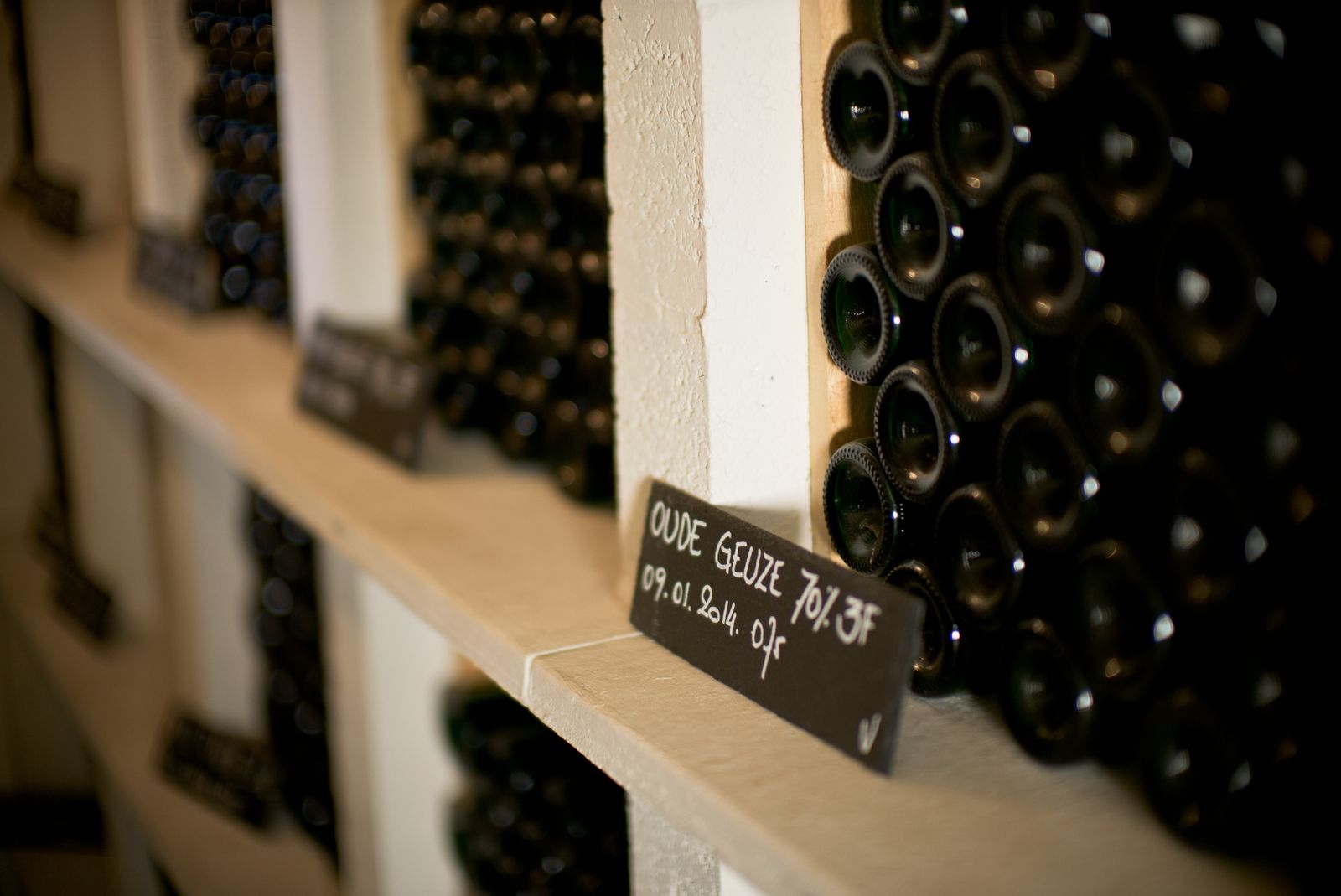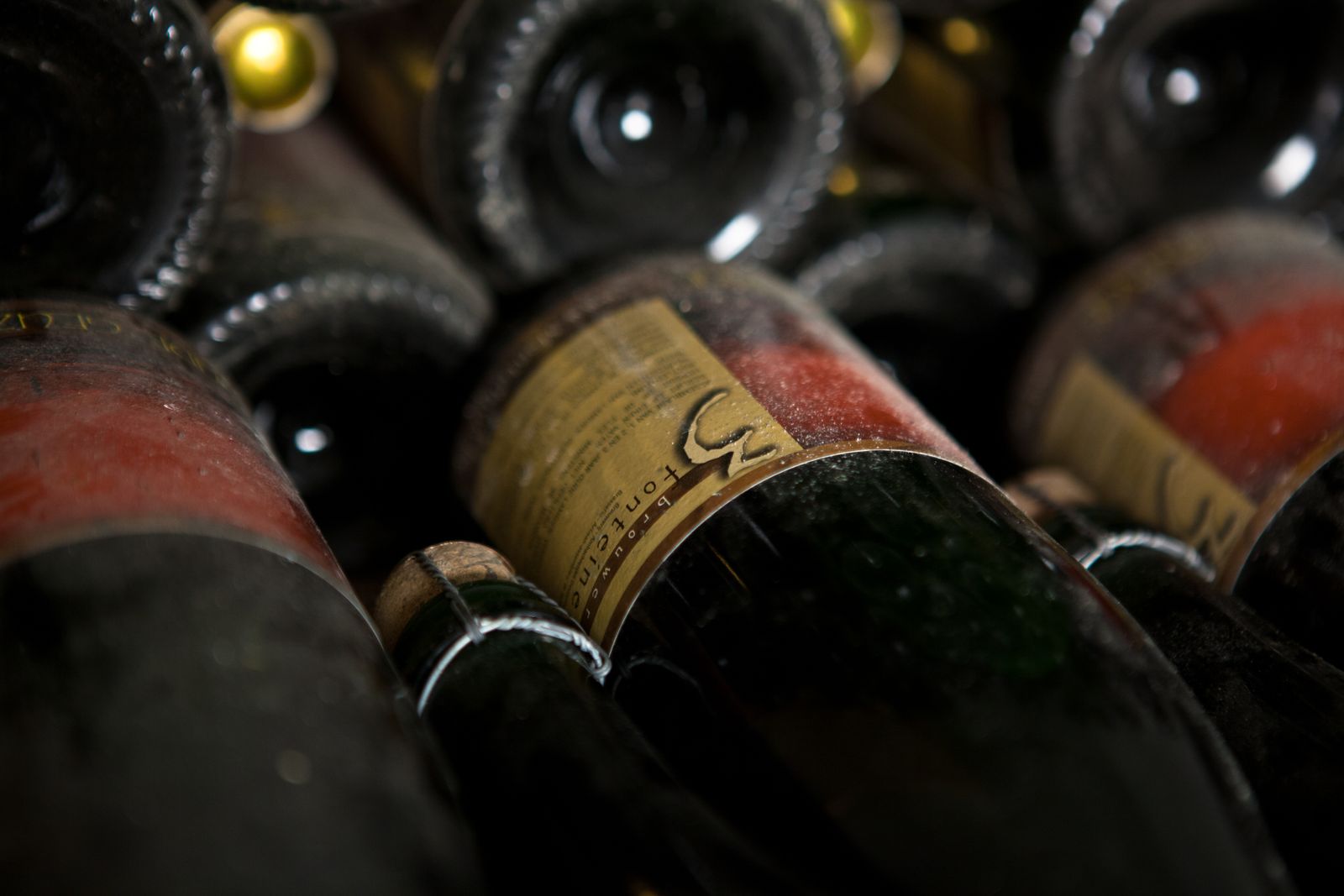The short answer: like a good bottle of wine. That's it. The long answer awaits below. You don't have to build a state-of-the-art acclimatised room in your house to keep a good geuze, just a few tips will make all the difference.
Have you seen the expiration date on the geuze you last bought? Indeed, it’ll last you for more than twenty years. And in fact, it can go even longer. Traditional geuze stores perfectly without losing its flavour. This is due to the typical brewing process and spontaneous fermentation, the elevation in wooden barrels, the high acidity (low pH), the absence of sugar and the high carbon dioxide level. A naturally-brewed beer just finds a way to preserve itself.
An aged bottle acquires accents of lime, passion fruit or stone fruit that its younger sisters haven’t developed yet.
Connoisseurs will find a heavily-aged geuze tastier, after blowing the gossamer layer of dust off the bottle. How come? The wild Brettanomyces yeasts have continued their work in the bottle at a leisurely pace. The geuze or fruit lambic beer also gently interacted with the air inside and with the additional oxygen that entered through the cork. The acids have esterified, which has made the aromas more complex, usually more fruity. An aged bottle has acquired accents of lime, passion fruit or stone fruit that its younger sisters haven’t yet developed. Sounds convincing, so how do you get your geuze this far?

Light.
The golden rule is: the darker the better. Make it pitch black if possible, but at least keep it dark. Light beams, especially ultraviolet rays, accelerate the wrong ageing process. (It’s a popular misconception that you only get UV from sunlight—artificial lighting is bad as well.) The colour of the beer will change, and what is worse: bright light causes oxidation, which goes hand in hand with a cardboard-like taste. That's why the glass of 3 Fonteinen bottles is so dark, to block out the light. The green ones are standard, the olive-brown ones are for blends that only contain home-brewed lambics.
The dark glass of the 3 Fonteinen bottles blocks out the light. The green ones are standard, the olive-brown ones are for blends that only contain home-brewed lambics.
Temperature.
Keep it fresh. The ideal temperature floats around 10 to 15°C (50 to 60°F), the typical Northern European cellar temperature. A bit warmer is not a problem, but do keep it below 20°C (68°F). Too high a temperature causes the beer to decay. Sudden temperature shifts are another no-no because they make the cork shrink and expand alternately. Let this happen a few times and the cork will loosen up. If it no longer closes properly, it will allow for too much contact with the air. A little contact is necessary, indeed that's what the natural cork was for, but you don’t want too much going on there. The result, again, would be oxidation and that spells disaster.
Humidity.
Moist air keeps the cork under tension in the bottleneck and reduces the risk of air leakage. The ideal humidity level lies between 70% and 80%. Somewhat higher moisture is not an issue in itself, but other problems will pop up if the room is not well ventilated. You don’t want any mould and you also don’t want the paper labels to decompose on the bottle. The ideal place is, of course, an underground cellar. Caveaus will always be naturally cool and perfectly moist. If you get to choose one or build one yourself, think of limestone or concrete: both these materials keep humidity at the right level.

Horizontally or vertically?
Here comes a crucial point. Traditional lambic beers need to be stored horizontally. This keeps the cork wet and under tension because it never loses touch with the beer in the bottleneck. A bottle that stands upright holds a vacuum of CO2 between the beer and the cap, which releases the tension. Secondly, when stored horizontally, the lees also spread more quickly and evenly to the bottom. This gives free rein to the Bretts, who further condition geuze in the bottle, all nice and quiet. If you don't have a cellar, just place the bottle somewhere flat at the bottom of a cupboard in the lowest room of the house. It's fresher there too.
Just as it would be sacrilege to kick a barrel of lambic in the barrel room, the geuze in the bottle also wants nothing more than a deep, deep sleep.
Agitation.
Vibrations are bad news for traditional lambic beers. They prevent the yeast cells from sinking quietly to the bottom of the bottle, which can make the beer’s evolution go awry. If you live close to a busy highway, railway, tram line or other heavy traffic, it's best to keep the geuze in a space as far from the streetside as possible. No, we are not exaggerating. Those yeasts just want peace and quiet. Just as it would be sacrilege to kick a barrel of lambic in the barrel room, the geuze in the bottle also wants nothing more than a deep, deep sleep.
What if I feel like tempting fate?
All that being said, what if I keep a bottle of geuze upright in full sunlight during a summer heatwave and then store it on top of my tumble dryer? What happens then? Quite simply, the bottle will explode. Armand still recounts his own experience on the matter, at least as far as those high temperatures are concerned. In 2009, the thermostat in the brewery's storage room broke down. Temperatures skyrocketed and one bottle after the other exploded. In the morning Armand found himself surrounded by a sea of geuze and glass shards. Those two AA batteries in the heat management almost meant the end of Brouwerij 3 Fonteinen. But that's a different story.
5 more tips for the proficient geuze guardian.
- If your cellar or storage area is not damp enough, it helps if you strew pebbles on the ground and sprinkle them with water every week.
- Provide regular ventilation in the room so that you don't get musty smells. This will also help to keep the temperature low. If you have a choice, then the north side is always the better option for ventilation.
- Storing geuze and fruit lambic beer is a wonderful investment in aroma and taste. If you don't have a cellar but do have the money, you could opt for a closed climate chamber. Always fresh, always moist.
- Radical geuze buffs say that you have to wait three weeks after each transport before you serve the bottle. That's overkill. Just don't pop it open right after it’s been stirred a lot.
- Air conditioning is ideal to maintain the temperature, but it also dries out the air. The cork will shrink too much.